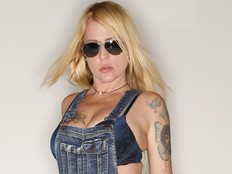Inside the 2025 Met Gala exhibit Superfine: Tailoring Black Style

Article content
Reviews and recommendations are unbiased and products are independently selected. Postmedia may earn an affiliate commission from purchases made through links on this page.
NEW YORK — When the email came from the Metropolitan Museum of Art, Jacques Agbobly at first didn’t quite believe it.
The Brooklyn-based fashion designer had only been in the business for five years. Now, one of the world’s top museums was asking for two of his designs to be shown in “Superfine: Tailoring Black Style,” the exhibit launched by the starry Met Gala.
Recommended Videos
“I was just floored with excitement,” Agbobly said in an interview. “I had to check to make sure it was from an official email. And then the excitement came, and I was like … am I allowed to say anything to anyone about it?”
Agbobly grew up in Togo, watching seamstresses and tailors create beautiful garments in part of the family home that they rented out. Studying fashion later in New York, the aspiring designer watched the Met Gala carpet from afar and dreamed of one day somehow being part of it.
“Superfine: Tailoring Black Style” is the first Costume Institute exhibit to focus exclusively on Black designers, and the first in more than 20 years devoted to menswear. Unlike past shows that highlighted the work of very famous designers like Karl Lagerfeld or Charles James, this exhibit includes a number of up-and-coming designers like Agbobly.
“The range is phenomenal,” says guest curator Monica L. Miller, a Barnard College professor whose book, “Slaves to Fashion: Black Dandyism and the Styling of Black Diasporic Identity,” is a foundation for the show.
“It’s super exciting to showcase the designs of these younger and emerging designers,” says Miller, who took The Associated Press through the show over the weekend before its unveiling at Monday’s Met Gala, “and to see the way they’ve been thinking about Black representation across time and across geography.”
The gala had already raised a record $31 million, Metropolitan Museum of Art CEO Max Hollein said Monday — the first time the fundraiser for the Met’s Costume Institute has crossed the $30 million mark and eclipsing last year’s haul of more than $26 million.
Defining dandyism
The exhibit covers Black style over several centuries, but the unifying theme is dandyism, and how designers have expressed that ethos through history.
For Agbobly, dandyism is “about taking space. As a Black designer, as a queer person, a lot of it is rooted in people telling us who we should be or how we should act … dandyism really goes against that. It’s about showing up and looking your best self and taking up space and announcing that you’re here.”
The exhibit, which opens to the public May 10, begins with its own definition: someone who “studies above everything else to dress elegantly and fashionably.”
Miller has organized it into 12 conceptual sections: Ownership, presence, distinction, disguise, freedom, champion, respectability, jook, heritage, beauty, cool and cosmopolitanism.
How clothing can dehumanize, but also give agency
The “ownership” section begins with two livery coats worn by enslaved people.
One of them, from Maryland, looks lavish and elaborate, in purple velvet trimmed with gold metallic threading. The garments were intended to show the wealth of their owners. In other words, Miller says, the enslaved themselves were items of conspicuous consumption.
The other is a livery coat of tan broadcloth, likely manufactured by Brooks Brothers and worn by an enslaved child or adolescent boy in Louisiana just before the Civil War.
Elsewhere, there’s a contemporary, glittering ensemble by British designer Grace Wales Bonner, made of crushed silk velvet and embroidered with crystals and the cowrie shells historically used as currency in Africa.
There’s also a so-called “dollar bill suit” by the label 3.Paradis — the jacket sporting a laminated one-dollar bill stitched to the breast pocket, meant to suggest the absence of wealth.
How dress can both disguise and reveal
The “disguise” section includes a collection of 19th-century newspaper ads announcing rewards for catching runaway enslaved people.
The ads, Miller notes, would often describe someone who was “particularly fond of dress” — or note that the person had taken large wardrobes. The reason was twofold: The fancy clothes made it possible for an enslaved person to cloak their identity. But also, when they finally made it to freedom, they could sell the clothing to help fund their new lives, Miller says.
“So dressing above one’s station sometimes was a matter of life and death,” the curator says, “and also enabled people to transition from being enslaved to being liberated.”
The contemporary part of this section includes striking embroidered jackets by the label Off-White that purposely play with gender roles — like displaying an ostensibly “male” jacket on a female mannequin.
Views of an emerging Black middle and upper-middle class
Stopping by a set of portraits from the early 19th century, as abolitionism was happening in the North, Miller explains that the subjects are Black men who were successful, well off enough to commission or sit for portraits, and dressed “in the finest fashions of the day.” Like William Whipper, an abolitionist and wealthy lumber merchant who also founded a literary society.
They represent the beginnings of a Black middle and upper middle class in America, Miller says. But she points out a group of racist caricatures in a case right across from the portraits.
“Almost as soon as they are able to do this,” she says, referring to the portraits, “they are stereotyped and degraded.”
Projecting respectability: W.E.B. Du Bois and Frederick Douglass
W.E.B. Du Bois, Miller points out, was not only a civil rights activist but also one of the best-dressed men in turn-of-the-century America. He travelled extensively overseas, which meant he needed “clothing befitting his status as a representative of Black America to the world.”
Objects in the display include receipts for tailors in London, and suit orders from Brooks Brothers or his Harlem tailor. There is also a laundry receipt from 1933 for cleaning of shirts, collars, and handkerchiefs.
Also highlighted in this section: Frederick Douglass, the abolitionist, writer, and statesman and also “the most photographed man of the 19th century.”
The show includes his tailcoat of brushed wool, as well as a shirt embroidered with a “D” monogram, a top hat, a cane and a pair of sunglasses.
Designers reflecting their African heritage
One of Miller’s favourite items in the heritage section is Agbobly’s bright-coloured ensemble based on the hues of bags that West African migrants used to transport their belongings.
Also displayed is Agbobly’s denim suit embellished with crystals and beads. It’s a tribute not only to the hairbraiding salons where the designer spent time as a child, but also the earrings his grandmother or aunts would wear when they went to church.
Speaking of family, Agbobly says that he ultimately did tell them — and everyone — about his “pinch-me moment.”
“Everyone knows about it,” the designer says. “I keep screaming. If I can scream on top of a hill, I will.”













Postmedia is committed to maintaining a lively but civil forum for discussion. Please keep comments relevant and respectful. Comments may take up to an hour to appear on the site. You will receive an email if there is a reply to your comment, an update to a thread you follow or if a user you follow comments. Visit our Community Guidelines for more information.